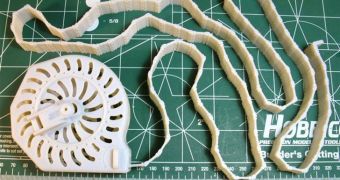It's still impossible to 3D print something as flexible or rollable as fabric, but that doesn't mean it's impossible to make rollable objects. Angry Monk just proved it by 3D printing a tape measure, of all things.
Tape measures are those small, box-like things that contain a long, narrow band marked with centimeters and inches. They can be several to a dozen feet/meters long, or more.
Usually, the measuring tape is made of a long, thin sheet metal, or a tough but flexible fabric, possibly with a layer of acrylic paint on top.
The one that Angry Monk just produced is made of plastic though. Plastic segments to be precise. Since it's not really possible to make plastic objects with the traits of fabric or flexible metal, not to mention the tensile strength, he made a measuring tape out of plastic parts.
So here it is, a long “band” made of 114 individual segment, 52 inches or tape links with graduations down to an eighth of an inch.
There's an error of 5 inches in the total length of the tape, but that's to be expected from a proof of concept, especially the first one ever.
Angry Monk meant his creation to be a “technology demonstrator” instead of something that builders should use when sectioning off the space for a home's foundation.
In addition to the tape itself, the designer made a belt clip, a lock and a foldout crank, plus a free-spinning handle that reels it back in. There's no build-in spring mechanism, apparently, to pull the tape back automatically.
All in all, the 3D printed measuring tape comes in a frame about the same size as a standard tape measure, but can't extend to the same length. That's the pitfall of the idea: the plastic segments are pretty thick compared to the standard tape.
Still, if nothing else, the project proves that you can do much more with a normal 3D printer (in this case the Objet Eden 3D printer from Stratasys). We might soon see 3D printed ropes, chains, puzzles, nets, and a multitude of other, “flexible” or knittable things.
Admittedly, as far as 3D printers go, the Objet Eden is among the better ones, the high-end sort used in industrial application. If you're using a normal, FFF 3D printer (fused deposition modeling, reliant on filament and a moving extruder head), you might not pull such things off easily, or at least not within normal budgets. It's only a matter of time before these barriers are surmounted though.

 14 DAY TRIAL //
14 DAY TRIAL // 